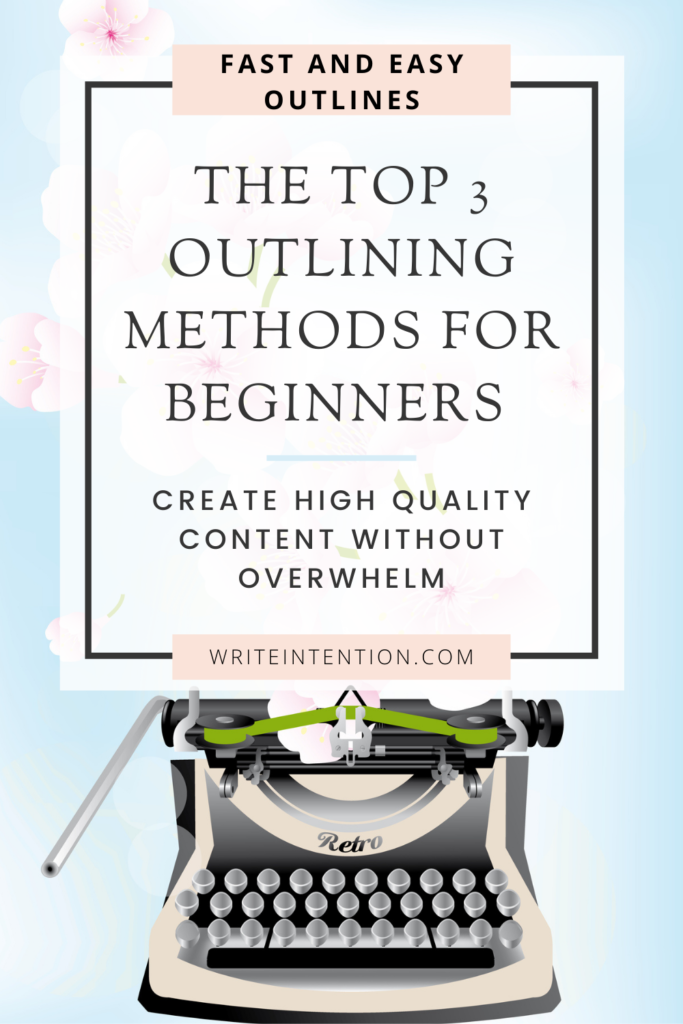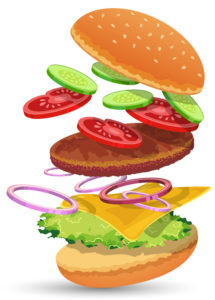Whether you are writing a book, article, video script, blog post or email – your fastest approach to quality content is to outline first.
Working from an outline always speeds up your content creation. If you have to write on the fly, it takes forever to map out the various points you want to make, try to remember all of them as you’re writing, and ensure each point is supported adequately.
Many people don’t even know how to create an outline. They may know how to write, or how to research – but outlining is a skill of its own. You don’t want to get bogged down in the outlining process, just as research and writing itself shouldn’t take too long.
There are a few ways you can outline. Some of it depends on what works best for your personal skills and style. Other parts of it depends on what kind of content piece you’re writing.
You might outline differently for a simple blog post (akin to an article) than you would when you create a complete outline for a full book. You always want to think of your audience and the goal you have with the content before you begin outlining.

Use a Standard Formula Article Outline
 In schools across America, many kids are taught how to write their first piece of content – an essay – using the popular “hamburger format.” Basically, it’s where the main ideas are sandwiched between an introductory paragraph and a concluding paragraph.
In schools across America, many kids are taught how to write their first piece of content – an essay – using the popular “hamburger format.” Basically, it’s where the main ideas are sandwiched between an introductory paragraph and a concluding paragraph.
This is a great visualization tool – a bun, holding a patty, lettuce and tomato – that reminds you of all of the working parts you need to convey in your written work. It sounds basic, but it works in niche content, not just education pieces.
Your introduction should hook your reader, and let them know what the piece is going to be about. You can do this with a statement, a question, quote, myth, or other method of your choosing. Your goal is to get them intrigued – have them thinking so they’ll want to read your take on it.
Main Point #1 is what you’re going to use to begin the persuasion or informing process. Here, and in the subsequent Main Point #2 and Main Point #3, you’re going to give the idea along with supporting information you have for it.
The first point can give an explanation of the main topic you’re writing about, to provide clarity and more background someone might need to grasp the topic. Your second paragraph could back up the idea with evidence and facts.
The last main point could be where you give an analysis or opinion about the issue you’re writing about. The conclusion is where you wrap it all up – you restate the main point and if you want to, give the reader instructions on what they should do next.
Some people dislike the words introduction and conclusion. You might want to use something else, such as purpose and call to action. This works for blog posts, articles, emails and other pieces of content you’ll be creating for your online business.
To use this in an outline, you would first think of the main point you want to get across, come up with three lessons, tips or ideas, and then a call to action. It might look something like this:
- Introduction: Meal prep removes many excuses for why you can’t lose weight.
- Main Point #1: Time is a big excuse, and this requires 1 day a week.
- Main Point #2: Convenience is a big excuse, and readymade, precooked meals help.
- Main Point #3: Eating too many calories is a big excuse and this is all pre-portioned.
- Conclusion: Buy a food scale and meal prep containers and download free recipe book.
If you wanted to, you could expand your outline to give more detail. For example, the third main point might look like this:
- Main Point #3: Eating too many calories is a big excuse and this is all pre-portioned.
- Eyeballing amounts makes it easy to mess up.
- You forget things you ate during the day, and little snacks add up.
- With meal prep you can make sure you have exactly 1,500 calories (or whatever) measured and packaged so you know not to go over.
It’s usually not that hard for people (even those not confident in their writing) to come up with three supporting statements for a concept. Any more than that, such as a list of 15 items, might be more intimidating. So this burger-style outline makes it easy for all.

The 5 Ws and an H
Whenever someone needs information, they may have a lot of questions. Nothing can cover all your bases quite like the 5Ws and an H can. These are the who, what, when, where, why and how questions.
Whenever you don’t know where to begin with your topic, write these words out and then answer the questions to get the ball rolling with your outline and content. Using a gardening example again, you might think about an outline for the generic topic of Container Gardening Tips.
So your outline might look like this:
- Who Is Container Gardening Good For?
- People in apartments or small spaces
- People on a budget
- Elderly or disabled who might have trouble being on their knees outdoors
- What Can You Grow in Containers?
- Tomatoes
- Lettuce
- Peas
- Where Is the Best Place to Position Container Gardens in Your Home
- Windows from seed
- By windows for plenty of light
- In rooms with plant growing lights
- When Are Container Vegetables Ready to Harvest?
- According to their official harvest schedule
- According to what you’re seeing on the vine
- Ongoing if plant allows for regrowth
- Why Would Someone Want to Begin Container Gardening?
- Less exhausting inside and out of the heat (also doesn’t require ground level work)
- To better their health – eating nutritious foods
- For stress relief (gardening itself and having greenery around them)
- How to Get Started with a Container Garden of Your Own
- Plan your space and decide on which containers you want
- Select the seeds or plants you want to grow
- Prep soil and begin the growing process, with a schedule for watering and harvesting.
Remember, you can reorder these in whatever logical order you see fit. If you think it’s important to say why someone should pay attention to this topic, then bump it up to the front of the piece you’re working on.
These issues can be swapped out, of course. For example, on the question of Why – instead of why would someone want to begin container gardening, you might use, “Why you should add stones to your container garden.” It helps with water drainage, prevents pests, and adds a nice décor.
This is the type of outline system that you can use over and over again. Because it’s so thorough, your readers will leave your blog feeling as if they got the advice they were looking for.
The Step-By-Step Outline Process
This outlining method is great for email campaigns when you’re wanting to build a list and you’re promising to show people how to do something in a step-by-step manner. It also works well for a blog post or a technical eBook, like how to set up an affiliate marketing blog site.
When you create your outline for this content, you need to organize it in a logical manner such as time, importance, etc. Some marketers will conduct thorough research but when they create their content, it feels a bit discombobulated to the reader.
That’s because, after the brainstorming session, the marketer didn’t put the outline together in the right order. This is frustrating for your audience because they may be working on something and then get told to do something a different way, and they have to backtrack because it wasn’t told to them any differently, earlier.
One great way to write an outline for a step-by-step content piece is to go through the process as you’re creating your outline. If it’s something you can’t do at that moment, like growing a garden, then at least visualize the steps you’d need to take so nothing is left out.
Never assume your reader knows something already. When going through the steps, even if it’s something you already know is a given, mention it so that they can make sure it’s part of their process, too.
How detailed will you be? You might not want to go through every single detail. For example, if your audience is mostly adept at blogging, and your piece discusses monetizing those blogs, then it may not be necessary for you to give them a step-by-step about installing WordPress.
What you might do instead is mention it in passing, and maybe link them to a free video or report that fills them in if they’re starting from scratch. Your step-by-step outline should primarily consist of everything you want to discuss in some depth.
For instance, it might look like this:
Step-By-Step Raised Bed Gardening
- Step 1: Measure for and Build Your Raised Bed
- Step 2: Make a Growing Plan Based on Your Zone
- Step 3: Prepare the Soil and Set Up Irrigation…and so on
Again, each step might have an outline for it, depending on how much you want to have waiting for you whenever you sit down to write your content. Under the measuring and building step, for example, you might have a mini step about deciding which material to use – plastic or a form of wood, etc. Or, you might have a tip about measuring and making room depending on which spot in the yard gets enough sun, etc.
Find the Right Filler Material
So what happens when you create your outline and it’s still looking a little on the thin side? You know you want more content in there, but you’re not sure what to put. You don’t want to stretch it out by simply using more words.
There’s a meme about this. At the grocery store, instead of a can just saying, “early sweet peas,” some manufacturers say things like, “very, very young, small, early sweet peas.” A company called Le Sueur does this, among others.
You want the right kind of filler material – the kind that your audience will welcome. There’s a difference between fluff and filler. Filler can benefit your audience and add to your points. Fluff is empty on value.
One thing you can do to fill up your outline and content is to use case studies in your work. So if you’re discussing weight loss, go ahead and tell your story. Or if you’re writing about stress relief, talk about what things you use to unwind when your anxiety is high.
If it’s financial in nature, go ahead and showcase your earnings and what you did to achieve that. This kind of filler material, based on real life accounts and efforts, is welcomed by your audience.
Personal stories do well as filler, as long as they’re relevant. It might not be a case study, where you’re showcasing what you did to get certain results. It might just be personalized accounts of things, such as how you balance work and life.
This kind of filler creates a connection with your audience. You can also add other research to the mix. This is different from a case study, but it might include research results someone else has done and what their findings were – just reference it and notate who it’s from in your content.
Put Your Outlining Skills to the Test
Map out your topic first. Should you go broad or narrow? Depending on how comprehensive your content piece is, it might be both – where you have a nice overview as well as some depth on each topic.
Once you have an outline created, consider whether or not you need to combine or expand chapters, once you analyze how much information you have to go in each section.
For example, maybe you have too much information to squeeze into one chapter. Think about how it could be split up into more than one chapter. Or, perhaps the opposite is true and a few of your chapters don’t have much meat to them. Can any of them be combined so they are more comprehensive?
Within your chapters, make sure you create subheadings. These work well to break up topics and large blocks of information for your readers and helps it all stay organized. It makes it easy for those who skim or speed read to gain knowledge without getting bogged down.
Don’t forget notes and filler stories when you’re outlining. Your notes will be little reminders you jot down to yourself about what your outline means. If your outline titles are vague or you may not recall all of the points you wanted to add in there, having a note in parentheses will help you recall it at the time of your writing.
A good example of a report you could write using these methods might be 20 pages of content, with five chapters at four pages each. Each of those five chapters could have several subheadings within them.
Or, you might arrange it so that you have 10 chapters of just two pages each. It all depends on how much information you find to share in the content. The pages and chapters don’t have to be uniform, either.
You might only have 7 chapters and one is 5 pages while another is just 2 pages. Don’t be a stickler for numbers, when it’s the content itself, not volume, that your audience is looking for. Just let it guide you on whether or not you need more research to give your readers a comprehensive piece of content.
Creating an outline is a great way to smooth the process of content creation for you. Remember to save your outlines in case you want to repurpose the material into a different media format later, such as a podcast, infographic or video.
If you want to learn more about outlining your first (or next) transformational book, then be sure to sign-up for my two free popular resources:
![]()


